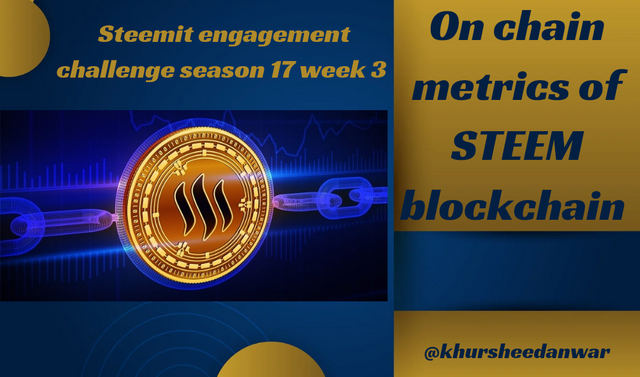
Onchain metrics are considered most important for evaluation of activities of users at STEEM blockchain so it provides one of the most valuable insights regarding the platform's adoption, it's active engagement level, and overall health of STEEM ecosystem.Here are the main onchain metrics indicators which can be used to check user activity at STEEM Blockchain.
1. Active Accounts:Active account is a metric which represents that how much there are number of unique accounts which re showing their interaction with STEEM blockchain in a particular time frame (like we can say as an example., daily, weekly, or monthly). If there would be higher number of active accounts then it would be the indication of increased level user engagement and participation at STEEM.
As an Example
Suppose in a particular time frame like in a week, there are 10,000 unique accounts which have posted diverse content, they also commented or engaged in other activities happening at STEEM blockchain then it indicates a strong user base.
2. Transactions Per Second:Transactions per second is again another metric measures which measure hat how much there are number of transactions processed at STEEM in one second. If there would be Higher TPS then it would be the indication of increased activity of users and more network congestion.
As an Example:
If you are attending a popular community event then suppose STEEM transactions per second surged to or have been changed to 50 transactions per second so it is a demonstration of the platform ability in handling high volumes of activity of users.
3. Block Size:Block size is again a metric which is representing total size of transactions within each block.If there would be larger block sizes then it would indicate an increased level of user activity and network utilization.
As an Example:
Suppose at STEEM there is a viral post and due to this block sizes at Steem has been increased to 20MB so in this way it is accommodating high volume of content generated by a user and it's interactions too.
4. Block Time:Block time is a metric measures which is responsible for measuring the time that it takes in mining and validating each block. If we are observing faster block times then these are indicating increased efficiency of network and user activity.
As an Example:
Suppose STEEM block time has been decreased to 30 seconds when there was a period of high user engagement so now it is causing faster transaction processing to happen which in return is improving overall performance of network.
5. User Retention: User retention is a metric which is used for calculating that how much percentage of users are returning towards steemit platform with the passage of time. If there is higher user retention then it shows that there is an increased level of user satisfaction and their engagement.
As an Example:
Suppose user retention rate at STEEM blockchain has been increased to 70% within a period of last three months then it shows that there is a loyal user base and worthiest community building efforts.
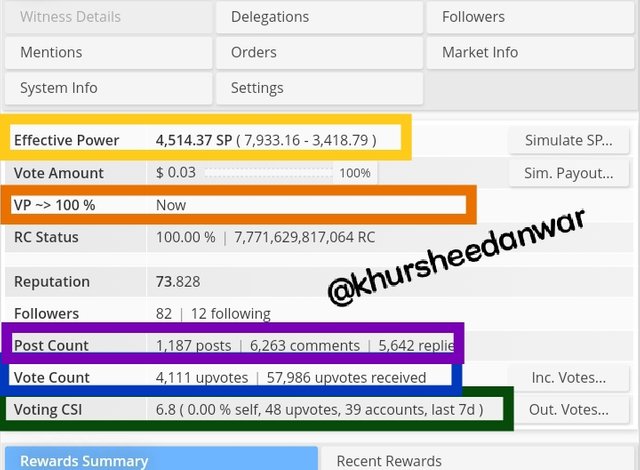
These are some of my personal account stats from which you can check how much my voting power is,how I am utilizing my voting CSI and how much people are using their voting CSI by voting at my content and how much posts I have created since joining and how much love I have received from steemit since joining in form of having followers,you all can see that information in screenshot
6. Posts:Posts is a metric which is used for measuring that how much thee are posts in form of different articles and different updates are updated by steemians at steemit.
As an example
If in last 7 days we have seen that there is more high quality content created with more number of posts then it shows that users are active and interested in creating high quality content.
7. Comments:Comments are another metric indicator which is responsible to keep an eye are number and quality of comments that users are leaving while showing their level of interaction with each other.High number of comments are directly proportional to uses interest in STEEM blockchain.
As an example
We all know that in steemit engagement challenge we have seen increase in number of quality comments and it is reflecting stronger level of engagement in between users.
8. Upvotes and downvotesUpvotes and downvotes are also an indicator which reflects that how much a post is likes and upvoted by others and how much content and due to which reasons are downvoted by you and by others respectively.Upvoted account are those that are receiving others appreciation and downvoted accounts are receiving others discouragement.
As an example
If you have seen a high quality content based on originality then there is always a need to appreciate it with an upvote and if you have seen a content with AI generated content then you can downvote the content for a user discouragement.
9. Followers:Followers is another metric which represents that how much people are impressed by your overall account performance and for this purpose other people may follow you for receiving continues updates of quality content from your account.
As an example
If my number of followers are increasing rapidly then it means users are loving my account activities and they are satisfied by my performance overall.
That was all about some of on-chain metrics at STEEM Blockchain that are used for analyzing different activities of users at STEEM.
If we analyze Onchain Metrics data from the STEEM then it is a way of providing most valuable insights regarding user engagement trends and evolution of community with the passage of time.
1. Identify key metrics:First there is a need to focus at metrics like accounts overall activity,transactions number in one Second (TPS), Sizeof a Block ,Block Time, Retention of users, and Content Creation.
2. Set a time frame:It is also very important to select a particular time period (like., weeks, months, or years) for analyzation of user engagement trends and evolution of community with time.
3. Visualize data: Using charts, graphs, or dashboards for visualization of data make it much easy to spot particular trends and patterns.
4. Look for correlations:You should also analyze that how different metrics are relative to each other because it guides and let you know about insights regard user behavior and growth of community overall.
5. Identify milestones and events:Identification of some significant events, updates, and new initiatives in community that can effect overall user engagement and community evolution is important to understand.
6. Compare with external factors:It is also important to keep in mind different external influences including market trends, global events, or social media hype because it can impact users engagement level at STEEM and community growth very easily.
As an Example:
- Suppose if you are analyzing Steem Onchain Metrics data within last 6 months period then at its analyzation it is is indication that ;
- There is a gradual and steady increase in number of active Accounts and content created on that accounts so in this way it is indicating that there is a level of growing user engagement and community growth.
- If by analyzing we have observed that there is a spike in transactions per second and Block Size during the time of community-driven token sale then it shows that there's an increased economic activity and participation of users at STEEM.
- If there is an improvement in user Retention rates after the initiation of new features then it's a great way of demonstrating enhanced level of user satisfaction.
- Suppose if there's a correlation existing between Token Velocity and Content Creation then it suggests that there is a significant relationship between economic activity and engagement of users.
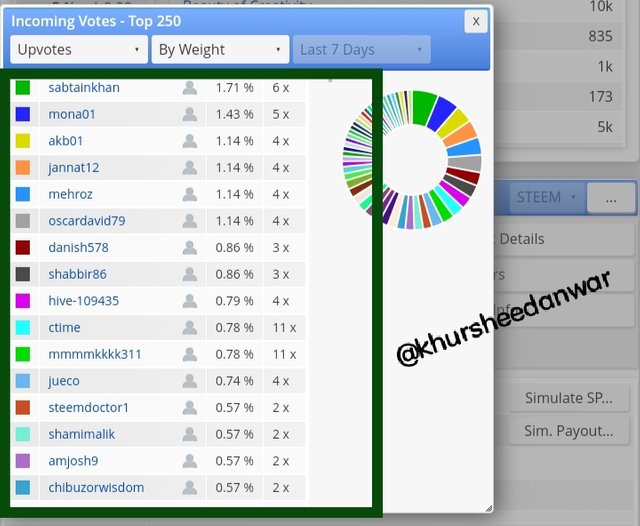
Here from the screenshot you can observe activities at my personal account that how much users are interested in voting my content so for that reason that are incoming upvotes I have shown.
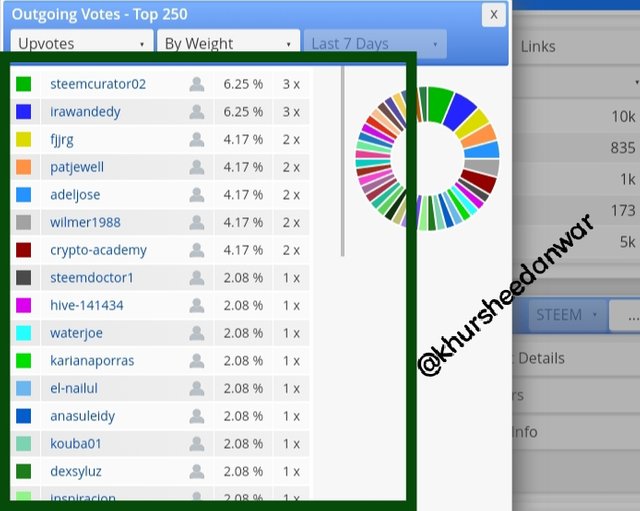
Below by utilizing my voting power in last 7 days I have also shown my level of activity in engaging with other by upvoting their content so these are outgoing votes to others accounts.
By analyzation of Onchain Metrics data, we can have a clear understanding of Steemit user engagement trends and community evolution, which enables as an outcome to make data-driven decisions for enhancing the platform and fostering an exciting community.
By interpreting Onchain Metrics at STEEM blockchain can pose some significant challenges due to its unique social structure and incentives. Here I am explaining some challenges with some examples:
1. Social influence:We all know about STEEM social features and community driven moderation so it can be impactful for metrics interpretation. We can say that if there is a popular post then it may receive many votes and comments which would skew in return engagement metrics.
As an Example:
Suppose there is a viral post which have received 1000 votes but most of votes are from a single community so it is inflating engagement numbers.
2. Incentivized behavior:STEEM token rewards and curation incentivization can be impactful for overall user behavior which is affecting metrics. Users can give more priority to earning tokens over creating quality content.
As an Example:
If there is a user which is posting low-quality content in a frequent manner for earning tokens then it would increase transaction volume but would decrease content quality from steemit.
3. Community dynamics:STEEM blockchain have a significant number of diverse communities so these communities can have different engagement patterns with its users that are involved with a particular community so it becomes very challenging in this way to generalize metrics.
As an Example:
If there is a community which is more focused on long-form content then there's might be a probability that it may have lower transaction volumes but higher times of engagement but if there's a community which is much focused on short-form content then there might be a probability that it may have high transaction volumes but lower times of engagement.
4. Gaming the system:If there are some users that are exploiting STEEM blockchain incentives then we can say that these are basically manipulating the metrics.
As an Example:
If there is a user who is creating multiple accounts or identities for the purpose of voting for his own content then it would artificially inflates the level of engagement metrics.
5. Data quality:We all know that STEEM have its decentralized nature so open source data which is present at steemit can be a leading cause of data inconsistencies and issues related to quality of content.
As an Example:
If there is a bug in a data scraper then it would cause less precision in counting of transaction which would overall affects metrics interpretation.
6. Contextual understanding:STEEM blockchain unique social structure and incentives also have requirement of contextual understanding for interpreting metrics in a precise way.
As an Example:
Suppose if there is a sudden increase in number of transactions then it is an indication of a community event or token sale rather than considering it an organic growth.
For overcoming some of these challenges, it is crucial to consider specific social structure and incentives of STEEM while interpretation of Onchain Metrics by the use of contextual understanding for ensuring precise insights.
Onchain metrics at STEEM blockchain can provide valuable insights for health of STEEM ecosystem. By analyzation of these metrics, we can approach different aspects of the platform vitality which includes;
1. Distribution of Voting Powers:If we focus on analyzation of distributing Steem Power (SP) and Voting Power (VP)then it is helpful for identification of centralization or concentration of overall influence of voting.If we want to see a healthy ecosystem at STEEM then it would shows a balanced distribution of utilization of voting power which indicates a diverse participation and minimized risk of manipulation.
2. Content Diversity:There are other metrics including number of post and comment counts, number of unique authors, and diversification in topics/categories can show the steemit platform content diversity.There would be a more vibrant ecosystem at STEEM if there would be a wide range of topics, frequent posts with quality ,and diverse participation of authors would takes place.
3. Reward Fairness: There are other onchain metrics which includes author rewards, curator rewards, and payout distributions and all these are helpful in evaluation of reward fairness.If we want to see a healthy ecosystem then it would shows a demonstration of a fair distribution of rewards, incentivization of quality content creation and curation.
4. User Engagement:There are other metric including number of active users, creation of new accounts, and retention rates of users indicate overall user engagement.This level of thriving ecosystem would exhibit consistent level of user growth and high retention rates.
5. Token Economy:Steem token metrics like supply of STEEM tokens, inflation rate of STEEM, and token velocity would help to assess the token economic health. If there is a balanced token economy then it would maintain a more stable supply of tokens, moderate inflation, and healthy token circulation.
6. Network Congestion:Transaction metrics including size of a block, volume of transactions, and confirmation times shows that how much there are network congestion levels.In a healthy steem ecosystem transactions would proceeds efficiently, with low level of congestion.
7. Community Participation:There are other metrics including witness participation, some other particular proposals, and voting turnout demonstrates community involvement.In a healthy ecosystem it would demonstrate active level of community participation, which have diverse witnesses and more number of engaged voters.
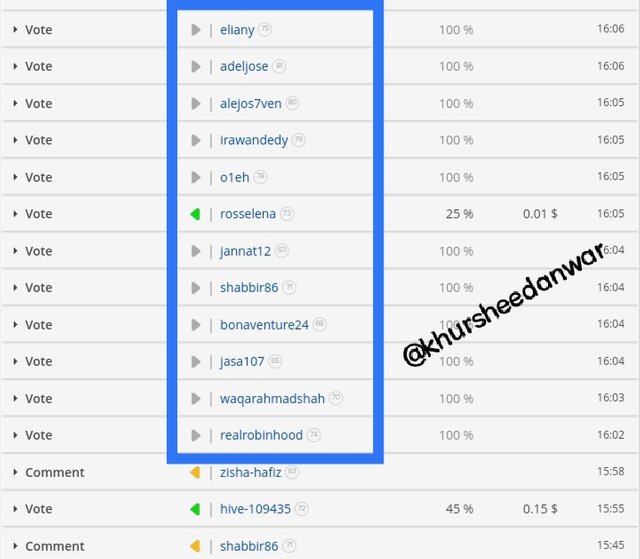
Now this is I am showing that how I am contributing myself in these on chain metrics by utilizing my voting power properly,by maintaining my voting CSI and by voting on diverse content so in screenshot it is clear that I have choosed different accounts with multiple content topics and diversity for utilizing my voting power.
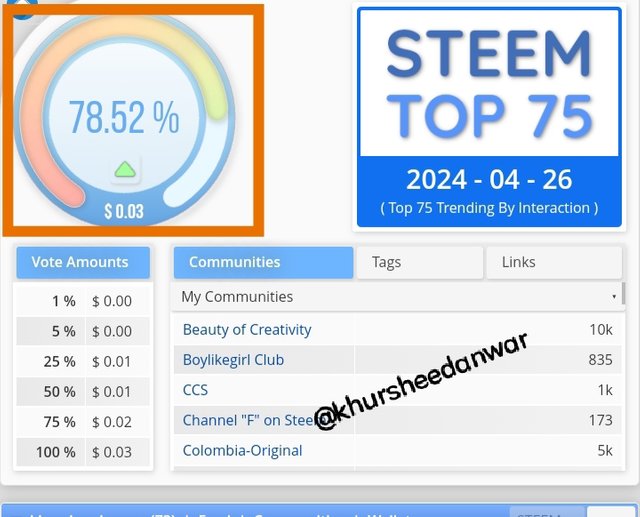
Below screenshot is showing that now after voting almost 13-14 accounts with 100% my voting power is around 80% so exactly it's 78% which means I can't vote more and I have successfully utilized my voting power.
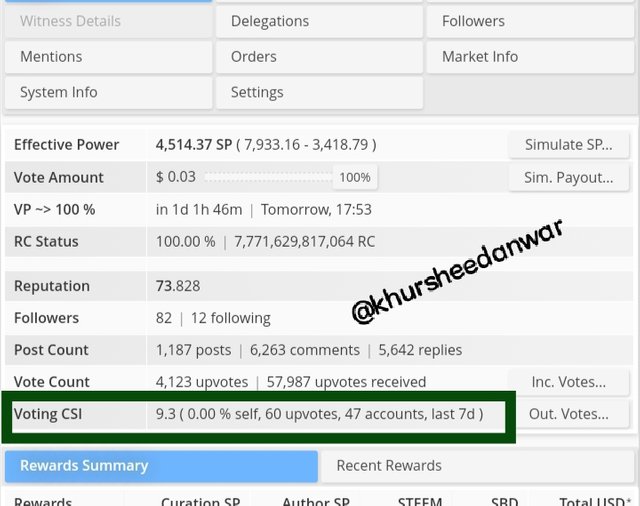
This is you can also see my maintained voting CSI in above screenshot which I have watermarked.
By analyzation of some of these onchain metrics stakeholders at STEEM can identify areas which have a room for improvement, tracking the effectiveness of changes which are implemented ,and make data-driven decisions to nurture more thriving ecosystem.
At STEEM blockchain developers can leverage Onchain Metrics for enhancement of platform usability, drive adoption, and for addressing scalability issues while upholding community integrity by:
1. Identifying user pain points:There is a need of analyzing different metrics like retention rates of users, transaction times, and rates of errors because they would be helpful for developers to notice areas that need improvement.
As an Example:
Suppose if transaction processing time is slow,then developers can optimize size of blocks and processes of transactions validation.
2. Optimizing user experience:There are some particular metrics including content engagement, voting patterns, and user behavior that informs design decisions are great way of enhancement of user experience.
As an Example:
Developers can easily make content discovery simplified by popular topics and authors highlighting that are trending.
3. Incentivizing desired behavior:Onchain metrics are responsible for guiding about development of incentives which encourage desired behavior of users like quality content creation and overall engagement of community.
As an Example:
It is easy for developers to introduce token rewards for that content which is of high quality so it is a way of fostering a diverse culture of quality content contributions.
4. Addressing scalability issues:There are other metrics including volume of transactions, size of block and network congestion which is a way of informing scalability solutions which gives surety that platform can handle growing user bases.
As an Example:
Developers can focus on the implementation of sharding or off-chain transactions for increasing throughput and reduction in congestion.
5. Upholding community integrity: Onchain metrics are helpful in identifying and mitigation of risks of manipulation which ensures integrity of community driven processes including voting and content moderation.
As n Example:
Developers can focus on implementation of algorithms which are able in detection of vote manipulation which ensures more fair content promotion.
6. Encouraging adoption:If I talk about metrics including user growth rates,volumes of transactions or velocity of tokens they can inform then about significant marketing strategies which can drive up users adoption and user acquisition.
As an Example:
Developers can focus in launching of targeted marketing campaigns when there are periods of high user growth and amplifying adoption.
By providing a leverage to these Onchain metrics developers at STEEM can create a more user friendly interface, scalability, and community driven platform,which drive adoption and growth by maintainance of overall integrity of STEEM ecosystem.
Greetings @khursheedanwar
Each answer you've provided shows that you have a deep understanding of On-chain metrics. These metrics are like measurements that help us understand how the Steem blockchain is performing. By analyzing these metrics, we can find ways to make the Steem blockchain ecosystem even better.
Another great aspect of your answers is that you not only understand the theory behind these metrics but also know how to apply them in real-life situations. This practical application is important because it helps us see how these metrics can be used to improve and maintain the Steem blockchain.
Your ability to connect theory and practice is like bridging the gap between what we know and what we do. It enriches the conversation around the Steem blockchain because you bring real-world examples and experiences into the discussion. This helps us understand the impact of these metrics on the Steem blockchain ecosystem.
You've shown that you really know your stuff when it comes to On-chain metrics and how they can be used to make the Steem blockchain better. Keep up the great work.
Downvoting a post can decrease pending rewards and make it less visible. Common reasons:
Submit
Thank you so much friend for being too much comprehensive while commenting and interacting with me and I am happy that you got a day understanding of on chain metrics of STEEM blockchain through my post as well as I agree with you that if we want to determine the overall performance and health of ecosystem of STEEM then there is always a need to delve into this topic.
I am really happy that you really love the way in which I have not only shared answers in a theoretical manner of all those questions but I have also explain that how all these questions could be applied in our real life by providing some special use cases and practical examples.
At last I am happy that you over all really like stuff of my post in which I have explained some of the base for developers that how they can enhance the performance of this blockchain.
Definitely I am trying my best to keep up the good work. I also want to advise you to all these be original when interacting with other users as you are. You are coming was as enjoyable as your post was that I have already visited...
Downvoting a post can decrease pending rewards and make it less visible. Common reasons:
Submit
TEAM 5
Congratulations! Your comment has been upvoted through steemcurator08.Downvoting a post can decrease pending rewards and make it less visible. Common reasons:
Submit
Upvoted. Thank You for sending some of your rewards to @null. It will make Steem stronger.
Downvoting a post can decrease pending rewards and make it less visible. Common reasons:
Submit
You have effectively highlights the importance of active accounts in indicating the strength of the user base on the Steem blockchain. You've
provided a clear example of how user engagement across various activities contributes to assessing the platform's health.
Yeah the role of developers in improving user experience by simplifying content discovery through highlighting trending topics and authors is crucial . I belive that would enhance platform usability to drive adoption.
The potential impact of leveraging Onchain metrics for developers to enhance various aspects of the Steem platform, including user experience, scalability, and community integrity is very well emphasized. It highlighs the importance of data-driven decision-making in fostering adoption and growth.
All the best
Downvoting a post can decrease pending rewards and make it less visible. Common reasons:
Submit
Thank you so much brother for your extensive comment at my post and for highlighting some of the points from my post and showing your perspective on these points.
I am happy that you really like onchain metrics explain by me that are helpful in evaluation of activity of users at platform and I agree with you that how much there are active accounts are always showing and demonstrating how much there is strength of user base at this platform as well as I am happy that you also like exemplification.
You also like my points that I have highlighted which developers at is blockchain can consider if they want to enhance and improve some of the issues arising at STEEM and how onchain metrics are important in it I have also explain them in detail as well as you really like the outcomes after enhancement of that some of the points in which there is a room for improvement and I agree with you that they would really be very helpful in fostering adoption and growth of STEEM blockchain.
Wishing you all the best to you too...
Downvoting a post can decrease pending rewards and make it less visible. Common reasons:
Submit
Congratulations, your post has been upvoted by @scilwa, which is a curating account for @R2cornell's Discord Community. We can also be found on our hive community & peakd as well as on my Discord Server
Felicitaciones, su publication ha sido votado por @scilwa. También puedo ser encontrado en nuestra comunidad de colmena y Peakd así como en mi servidor de discordia
Downvoting a post can decrease pending rewards and make it less visible. Common reasons:
Submit
Thanks a lot for supporting me and curating my content
Downvoting a post can decrease pending rewards and make it less visible. Common reasons:
Submit
Dear ❤️ you are right that block size block time transactions per second and retention of users all are important for analysing onchain metrics and by the determination of all these things we can very easily observe the level of participation and active users at the platform. Proper practical examples in each and every question are a great way of making your concepts and knowledge more stronger to understand for all of us. I wish much success to you.
Downvoting a post can decrease pending rewards and make it less visible. Common reasons:
Submit
Thank you Soo much for giving a brief overview of my post and I'm feeling great thar you really like to understand on charge n metrics for understanding users activity at STEEM and my practical examples are helpful and impressive for you 🙂
Thank you Soo much for wishing me success...
I wish same for you....
Downvoting a post can decrease pending rewards and make it less visible. Common reasons:
Submit
Lo interesante de la blockchain es que es un libro abierto o público e inalterable que registra cada paso que damos en la red, en tal sentido, nos podemos mirar en el espejo de las métricas para una excelente autoevaluación en nuestras actuaciones, así mismo podemos verificar lo que está pasando dentro de otros usuarios.
¡Gracias por compartir, saludos y éxitos!
Downvoting a post can decrease pending rewards and make it less visible. Common reasons:
Submit
I appreciate your comment as my post as well as I agree with your statement that blockchain is decentralised that's why it is public and open for everyone which make it more easier to have an outlook on it's on chain metrics. we can know and make an assessment about STEEM performance.
Overall I appreciate your understanding of topic explained by me and thank you so much for wishing me a lot of success...
Downvoting a post can decrease pending rewards and make it less visible. Common reasons:
Submit
¡Es un placer!
Downvoting a post can decrease pending rewards and make it less visible. Common reasons:
Submit
Thank you for responding back brother 😀
God bless you ❤️
Downvoting a post can decrease pending rewards and make it less visible. Common reasons:
Submit
TEAM 5
Congratulations! Your post has been upvoted through steemcurator08.Downvoting a post can decrease pending rewards and make it less visible. Common reasons:
Submit
Thanks @sduttaskitchen
Downvoting a post can decrease pending rewards and make it less visible. Common reasons:
Submit